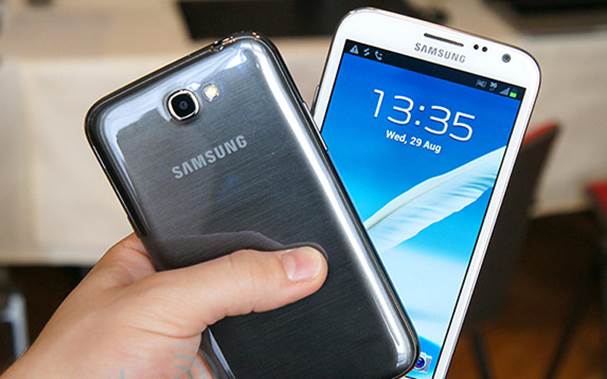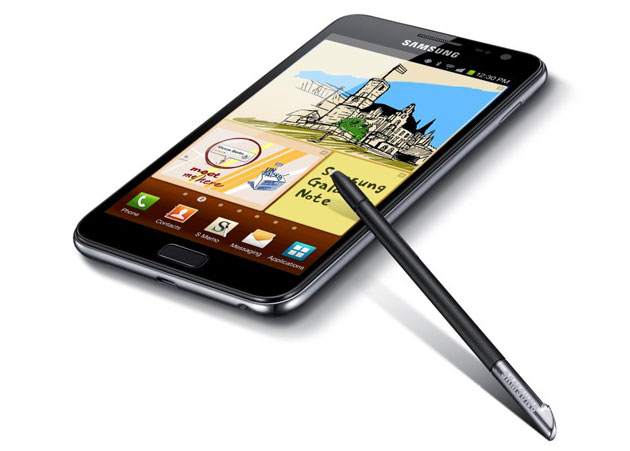The surprise hit of the last year gets a
full update. The Note II comes with an even larger screen and a revamped stylus

Samsung
Galaxy Note II
Screen upgrade
The screen measures 5.5 inches and is a
marked upgrade over both the original Note and the S III. It is a stunning
display
Capacitive buttons
Like the Sill before it, the Note II has
capacitive buttons, for Back and Menu, below the screen. We would have
preferred on-screen buttons on a device of this size
Phone speaker
Yes, this is a phone. Despite its size
Samsung expects you to hold it to your ear to make calls with. Might be time to
invest in a Bluetooth headset!
Jelly Bean and TouchWiz
The Note II is the first Samsung device to
launch with Jelly Bean. It is skinned with a newly updated and tweaked version
of its popular TouchWiz Ul

It
is skinned with a newly updated and tweaked version of its popular TouchWiz Ul
Home button
The Home button stays in place: a quick
press returns to the home screen, long press opens the task switcher and
double-tap opens the S Voice app
S Pen
Try to walk off with the S Pen still sat on
a table and the phone will sound an alarm to let you know
The original Samsung Galaxy Note, unveiled
a year ago, caught the industry offguard. For many it seemed like a parody of
the trend for ever-increasing screen sizes, while the inclusion of a stylus was
a curious throwback to the early days of mobile computing. But Samsung had done
its research, and the Note sold 10 million units. And now the range has been
extended with both a ten-inch tablet and a new 5.5-inch device that still
nobody knows what to call. Is it a phone, is it tablet? Please, not a
‘phablet’. And if you buy it, which of those two devices does it replace? Let’s
find out.

Try
to walk off with the S Pen still sat on a table and the phone will sound an
alarm to let you know
Hardware and design
Despite being the third Note device, the
range has yet to develop its own design identity. The Note 10.1 stands
completely apart, and for the five-inch versions they borrow the look of the
year’s flagship ‘S’ device - last year’s Note was an oversized Galaxy SII; the
Note II is a big Galaxy S III. The presence of the S Pen is the only consistent
feature, the only thing that makes a Note a Note.
As a result the Note II, like the S III
before it, is not the prettiest device we’ve ever seen but neither is it
particularly offensive on the eyes. The build is plastlcy and can feel a touch
cheaper than you might like for a high-end device, but it has proven itself to
be sturdy enough on the S III and so should be here too.
However you choose to look at the Note II
there’s no escaping the fact that it is a big device. It still slides into a
trouser pocket easily enough but you know that it is there. It is big to hold
in one hand and you might find your fingers have to stretch even to grip the
other side. It is never a one-handed device - Samsung has introduced a
one-handed operation mode to the software, which reduces the size of things
like the keyboard and lockscreen pattern so they are within reach of your
thumb, but for the most part, even normal daily tasks require two hands to use.
Not that this should be seen as a negative at all. It is simply a fact of this
particular Android smartphone.

The
S Pen is excellent for drawing and handwriting recognition
A quick tour around the Note II reveals a
power button well located two-thirds of the way up the right-hand side with
volume rocker opposite, headphone jack on the top and micro USB port and S Pen
silo on the bottom. On the back is the camera, LED flash and speaker. To get to
the SIM card and micro SD slots you must remove the back cover. Beneath the
screen are the omnipresent Home button and two capacitive buttons for the Menu
and Back functions. This is in line with other Samsung devices, but in this
instance it would have been nice to have seen the company adopt the button-less
approach that Google is currently advocating for Android.
The 5.5-inch screen is larger by 0.2 inches
than its predecessor and has been upgraded over the S III as well. The 720 x
1,280 pixel Super AMOLED screen has a lower pixel density but is not a PenTile
display, resulting in sharper and crisper text and images. Admittedly we've
never had any issues with this on the S III but putting the two side-by-side
does show a noticeable difference in favour of the Note II. The HTC One X still
gets our vote for best screen on an Android smartphone, but this is not far
behind.